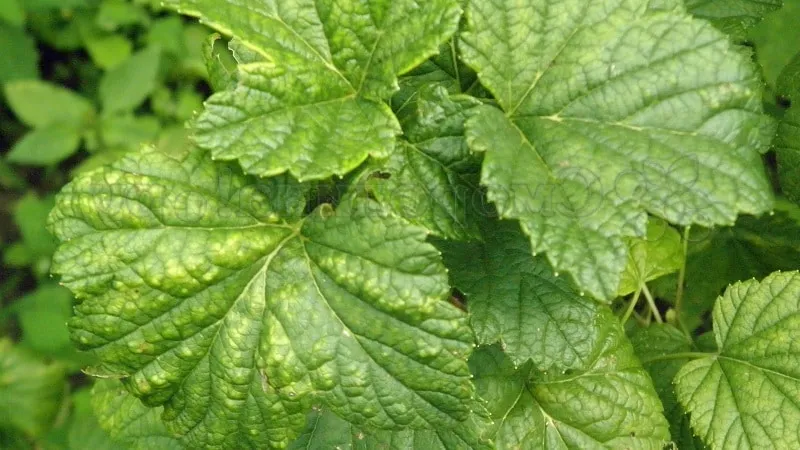Combating diseases is a crucial part of caring for currants. Without preventive and therapeutic measures, you may not see a harvest. One of the most dangerous diseases is currant mosaic virus. The disease is characterized by its sudden onset and is difficult to treat. Learn what to do about mosaic virus on currants and which remedies to use in this article.
Table of contents
What is currant mosaic virus?
Mosaic virus is a common viral disease affecting garden shrubs, including red, green, and black currants. It infects both young and mature plants at any stage of the growing season.

Pathogens and spread
The disease is caused by viruses. Mosaic virus appears due to chloroplast damage. Cellular structures break down, leading to a significant reduction in carbohydrate levels. As a result, tissue areas die, and the first symptoms of infection appear.
The mosaic virus spreads through mechanical damage to currants, such as during pruning of mature shrubs or transplanting seedlings. The disease is transmitted through contact between healthy and infected plants, as well as by wind and rain. Another vector for the virus is garden pests: aphids, bugs, mites, and other insects. Additionally, birds and animals can spread the virus through fruits and seeds.
Important! Often, the source of the virus is garden soil. It may contain last season's weeds, plant debris, and fallen leaves. Therefore, before planting, gardeners should remove all debris from the area, burn it, and maintain clean soil afterward.
Damage caused
If mosaic virus infects seedlings, plant growth and development slow down. If it affects mature bushes, the currant's immunity weakens, yields disappear, and the plant gradually dies. Such bushes cannot be restored—they must be removed and burned.
The difficulty lies in the delayed symptom onset. By the time characteristic spots appear, neighboring fruit trees and shrubs may already be infected.
Types of mosaic virus
There are several types of currant mosaic virus—striped and interveinal white mosaic. Striped (vein) mosaic virus appears due to aphids and mites or from grafting an infected cutting onto a healthy bush.
Large, bright yellow patterns form on the leaves, with veins clearly visible. The disease is untreatable—infected bushes must be uprooted and burned, while the soil and remaining plants should be treated with copper sulfate or pesticides.
Interveinal white mosaic virus primarily affects red currant varieties. Infected bushes grow poorly, and gardeners notice faded leaves and shoots. The virus spreads through the sap of infected plants and by wind.
Mosaic-infected leaves develop blurry light-yellow or white spots that intensify in color over time. If detected early, interveinal white mosaic can be treated with chemicals.
Causes
The spread of mosaic virus is often due to improper planting techniques and errors in agricultural practices. For example, currants can easily become infected during pruning when pathogens enter small wounds and cracks.
High humidity and temperatures above +25°C also contribute to infection. The virus often targets weakened plants with nutrient deficiencies. Such bushes have poor immunity and cannot resist the virus. Therefore, lack of fertilization is another cause of infection.
Symptoms and visible signs of infection
A key symptom is the appearance of white or yellow spots of varying sizes and shapes on leaf blades. The virus disrupts metabolic processes—currants grow slower, shoots weaken, and gradually dry out. Tall, bushy shrubs wither quickly.
If the virus strikes in mid-summer when berries have already formed, they deform and fall prematurely. The fruits lose their marketable appearance, taste, and nutritional value. Consuming them is not recommended—they slowly rot from the inside due to the virus.

How to treat currants for mosaic virus
Gardeners use chemicals, folk remedies, and agricultural techniques to treat currants.
Combining these methods yields faster results and helps preserve the harvest.
Chemical treatments
A popular treatment is "Sulfur WG". This fungicide, acaricide, and fertilizer combination is used for various currant varieties. To prepare the solution, mix 20 mg of the product in 10 liters of water and apply 5 liters per 1 m². Treat currants three times at 10-day intervals. Besides combating mosaic virus, "Sulfur WG" protects berry shrubs from aphids, mites, and fungal diseases. Sold as water-soluble granules.
For treating striped mosaic virus, the systemic fungicide "Score" is effective. Dissolve 2 g of the product in 10 liters of water and spray currants at a rate of 1 liter per 10 m². After treatment, some residue remains in the upper plant tissue, protecting against further viral penetration. Apply "Score" once before flowering and again after 5-10 days.
Important! Treat currants on a windless day, in the morning or evening. Ideal temperature is around +20°C. Water the plants and remove weeds before application. Avoid grass and leaves near the bushes.
Agricultural techniques
Agricultural methods cannot cure the virus but enhance chemical treatments and prevent outbreaks. One approach is timely removal of plant debris.
Currants dislike overcrowding and weeds, which steal nutrients. This weakens the shrubs, making them more susceptible to viruses. Regular weeding and loosening improve soil aeration and nutrient absorption.
Essential in currant care is disinfecting planting material. Purchase seedlings in autumn or spring, depending on planting time. Healthy seedlings should be flexible, light gray, with 3-4 young shoots. After purchase, wrap roots in a damp cloth and disinfect the planting site with potassium permanganate or boiling water before planting.
Folk remedies
Folk methods work best in early infection stages and use readily available ingredients.
An iodine solution (10 ml in 10 liters of water) is applied 3-5 times per season at 10-day intervals. It also combats powdery mildew and root rot caused by excess moisture.
Ammonia solution (40 ml ammonia + 50 g grated soap in 10 liters of water) deters pests that spread the virus. Avoid watering for 2-3 days after application.

Treatment specifics for black, red, and white currants
To save red currants from interveinal white mosaic, gardeners use Bordeaux mixture. It doesn’t burn plants, acts quickly, and is safe. Mix 100 g per 10 liters of water and apply 1.5 liters per bush every 2 weeks. This treatment also strengthens immunity.
Before treating black or white currants, loosen the soil thoroughly. The root system lies 50-60 cm deep, so nutrients must penetrate deeply for effectiveness.
Preventive measures
Prevention is the most effective defense. Beyond healthy seedlings and proper planting, gardeners should:
- Disinfect tools (shovels, rakes, supports) with potassium permanganate before planting.
- Spray bushes with lime solution (2 kg lime + 300 g copper sulfate in 10 liters of water) in spring to kill insect larvae.
- Rotate planting sites every 7-10 years, spacing bushes 1.5-2 m apart in sunny, well-ventilated areas.
- Collect and burn fallen leaves in autumn, then spray plants with hydrogen peroxide and cover with agrofabric.
Resistant currant varieties
Choose varieties with strong immunity to mosaic virus. For Central Europe, mid-late varieties like "Ben Lomond" and high-yield "Titania" are recommended. They are hardy and versatile.
For Northern Europe, "Ben Nevis" and "Ben Alder" are productive and disease-resistant. In Southern Europe, drought-tolerant "Ojebyn" and "Rovada" thrive.
Tips from experienced gardeners
The key advice: don’t wait for symptoms—implement preventive measures early.
Currants aren’t overly demanding but need consistent care.
Gardeners recommend:
- Regularly inspecting plants for signs of infection.
- Starting treatment immediately if detected.
- Spraying neighboring shrubs during treatment.
- Weeding and loosening to deter pests, including rodents.
- Following safety precautions when using chemicals.
Conclusion
Mosaic virus is a pathogen that destroys currants from within. It’s identifiable by white, yellow, or green blotchy patterns on leaves.
Treatments include chemicals ("Sulfur WG" or "Score") and folk remedies (iodine or ammonia solutions). Prevention involves loosening, fertilizing, and removing weeds. If plants cannot be saved, remove and burn them.







